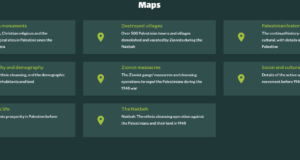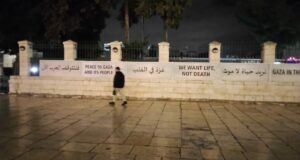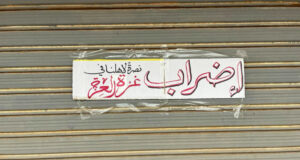This photo series is meant to visually document some of the claims made by international human rights observers in their reporting of the crimes of the Israeli Occupation during the seige in Nablus on 26th August. These pictures were all taken by international activists throughout the day. The original press release documenting these incidents is on the ISM website.
The occupation forces’ wrecking equipment destroys a small home in order to reach the Labadda house. Three homes were destroyed in this manner, to make room for the Caterpillar equipment to park within wrecking distance. While the Labadda house appears to be the target of the demolition, three homes were completely leveled that surround the three-story structure.
On the north side of the Labadda house, Ameican-made Occupation bulldozers destroyed three cars and dumped the wreckage on top of a neighboring house. The bulldozer is about to drop the third car; in view are two cars previously dropped onto the porch of the neighboring home. Earlier in the day, these cars were used by Occupation forces to blockade the street, and when they were no longer useful, they were dumped on the house.
The southern side of the Labadda house. Throughout the day, Occupation soldiers shot relentlessly into the building with machine gun fire and grenades. These bullet holes represent only a small section of the pock-marked wall. Most of the southern wall below this image was completely destroyed by Caterpillar wrecking equipment.
A man, trying to reach his home is made to unbutton his shirt and turn around to show that he is not carrying explosives. Occupation soldiers forced many Palestinians to do this while residents attempted to evacuate family members from their homes within the firing range.
An elderly man is detained on top of a neighbor’s car from the begining of the incursion until late in the afternoon. Many neighbors confronted the soldiers to seek the elderly man’s release but were unsucessfull. Though the man lived very close to the point of detention, he was prevented from returning to his home and instead made to wait on the car in the hot sun.
The top floor of the home was occupied by soldiers and used as a firing position. This is the site of one incidence of the Occupation’s illegal use of Palestinian human shields. When soldiers seized the apartment as a sniper nest, they kidnapped six Palestinian men and forced them to remain in the apartment, while the soldiers fired over their heads. This was intended to prevent Palestinian resistance fighters from returning fire into the sniper nest.
A small sample of spent M-16 shells collected from the apartment used as a sniper nest. After the incursion, the residents bagged the shells and showed them to international human rights observers. From their post in the apartment, Occupation forces fired hundreds of rounds at the Labadda house, neighboring homes and Palestinian demonstrators.
A Palestinian ambulance is prevented from entering the area to evacuate a Palestinian child hurt during the incursion. After a great amount of delay, intense negotiations, and a military search of the vehicle, the ambulance was permitted passage to evacuate the child. If the child’s injuries had been severe, this delay could have resulted in his death.
The position Occupation soldiers started firing at unarmed Palestinian demonstrators from a distance of over 100 meters. During these encounters over 20 demonstrators were shot and injured, and 15 year old Montasir from Askar refugee camp was killed.
Occupation soldiers forcefully enter and occupy the elemtary school bordering the Labadda house. From this position, soldiers fired at Palestinian demonstrators assembling on Amman street and the neighboring smaller streets.
A small home demolished in order to allow the American-made Caterpillar wrecking equipment a parking spot to position itself in order to demolish the main target building. Three homes surrounding the target building were demolished in a similar manner.
The damage sustained to the north eastern corner of the Labadda house, an apartment complex that housed 17 families, 8 of which are from the Labadda family.
Palestinian volunteer medics escort residents through the partially demolished Labadda house in search of their valuables and keepsakes.
Palestinian volunteer medics escort residents through the partially demolished Labadda house in search of their valuables and keepsakes.
A Palestinian boy stands in front of a pile of rubble, formerly a home, and two demolished cars crushed during the incursion. At least eight Palestinian cars were destroyed during the incursion.
 International Solidarity Movement Nonviolence. Justice. Freedom.
International Solidarity Movement Nonviolence. Justice. Freedom.

















